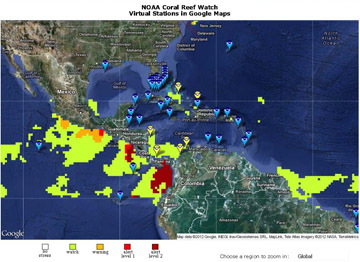MONITORING

Monitoring, in many different forms, is an essential part of the science efforts at Flower Garden Banks National Marine Sanctuary. Click on the links below to visit each of the following categories on this page:
Water Quality
Long-Term Monitoring
Coral Bleaching
Coral Spawning
Hurricanes & Tropical Storms
Marine Debris
WATER QUALITY

During each cruise, opportunistic temperature and salinity profiles are measured by staff researchers using a YSI probe deployed by hand. These data compliment the data collected by stationary water quality instruments on the sea floor at each bank by giving additional information about the conditions at the surface and throughout the water column.
YSI Temperature Data June 2005-May 2011 (246kb pdf)
YSI Salinity Data June 2005-May 2011 (102kb pdf)
In addition, the R/V Manta is equipped with a SeaKeeper 1000 monitoring system. This automated system continuously monitors weather and ocean parameters while the ship is underway. The data is available on board the vessel and remotely via satellite.
The SeaKeeper 1000 tracks the following parameters:
- Salinity
- Sea Surface Temperature (SST)
- Dissolved Oxygen
- pH (acidity or alkalinity of sea water)
- eH (potential of sea water to oxidate materials in suspension)
- Wind Speed & Direction
- Relative Humidity
- Barometric Pressure
- Air Temperature
You can view the most recent data sets from the R/V Manta, by visiting our Office of National Marine Sanctuaries Ocean Observations page.
Once you have linked to the page, select RV Manta as the Ship Name in the top left corner, then click "Find It". You can then click on the red lines/dots that show the Manta's latest trip or select specific observation data from the column on the right side of the page.
To learn more about the SeaKeepers Monitoring system, visit the International SeaKeepers Society web site.
top of page
LONG-TERM MONITORING

The three banks of Flower Garden Banks National Marine Sanctuary are monitored on an annual basis as part of a Long-term Monitoring program. This program, which first began at East and West Flower Garden Banks, is one of the longest long-term monitoring programs of a coral reef anywhere in the world!
For more information on long-term monitoring activities and reports, please click on the links below.
Long-term Monitoring: East and West Flower Garden Banks
Long-term Monitoring: Stetson Bank
top of page
CORAL BLEACHING

The Gulf of Mexico is known for very warm summer waters that spawn hurricanes. These same temperatures can cause coral bleaching, a recurring problem on coral reefs around the world.
For more information about coral bleaching in the sanctuary, please click on the links below.
Coral Bleaching Basics - brief explanation of coral bleaching and what causes it.

Remote sensing map from NOAA's Coral Reef Watch
virtual stations website
Remote Sensing through NOAA Coral Reef Watch - use this site to see what sea surface temperatures have been like in the sanctuary this year and how close they are to the bleaching threshhold.
ADDITIONAL MONITORING

Additional monitoring efforts are also undertaken in response to significant events in and around the sanctuary. These include annual occurrences such as the mass coral spawning, as well as intermittent events and ongoing problems.
For more information on these monitoring activities and reports, please click on the links below:
Coral Spawning
Hurricanes and Tropical Storms
Marine Debris
top of page